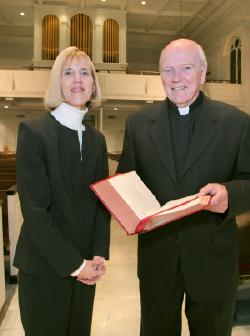Issue Date: January 23, 2004
By JOE FEUERHERD It is not Vatican directives that have stalled liturgical renewal in the United States (though disputes over such issues as use of inclusive language continue). Nor is lay hostility a great concern -- though tempers can flare when liturgy committees and pastors recommend physical changes to worship space. And America’s bishops, by and large, don’t pose an obstacle to fully implementing the liturgical reforms envisioned by Vatican II. So nearly 40 years after the laity’s role in Roman Catholic liturgy was expanded, use of vernacular language mandated and scripture fully embraced, what’s holding renewal back? Apathy. “The level of interest is really low now,” says Jesuit Fr. Lawrence Madden, director of the Georgetown Center for Liturgy. A little more controversy, said Madden, wouldn’t necessarily be a bad thing. “It would be better for the business of liturgy if there were some real struggles going on.” Continued Madden, “I remember the days when the bishops were very suspicious of the [Evanston, Ill.-based] Liturgical Conference, they were very suspicious, but now it’s like they are uninterested,” Madden said. “Other things are preoccupying people.” One sign of the times: “There is not a glut of people trying to get into liturgy programs now,” said the center’s associate director Anne Koester, a lawyer who received her master of arts in theology with a concentration in liturgy from St. John’s University in Collegeville, Minn., in May 2002. Madden is no stranger to struggles past. For more than two decades, he has headed the center, a joint project of Georgetown University and neighboring Holy Trinity Parish. His calming influence as Holy Trinity’s pastor in 1990s is credited with defusing tension (much of it involving liturgical issues) between the Jesuit-run parish and the Washington archdiocese. Some feared (and others hoped) that then-Cardinal James Hickey would order the Jesuits out of Holy Trinity, a parish they have administered for more than two centuries. Today, the center’s programs include conferences, consultations, workshops and books -- all toward the goal, says Koester, of “helping people pay attention to the liturgy, helping them understand so that they can feel it in their bones and understand how central it is to Catholic identity and to their way of living life.” The good news: “If you do good liturgy, you’re going to attract people -- they will come.” The bad news: By Madden’s estimates only one in 10 U.S. parishes “are doing a really good job.” On a practical level, much of the center’s activities focus on priestly presiding and preaching. In addition to its numerous workshops, the center is about to launch a program where, for a charge of $100, a priest or deacon can send a videotape of their “performance” to the center, which will then have it critiqued by a panel of experts. Another new initiative: The center will host a Web site and produce written materials for parishes building or renovating their worship spaces. Artists, designers, architects and others will contribute to the site, which aims to provide a central resource for parishes that want their physical plants to enhance their liturgical objectives. Over the past two years, more than 1,600 people attended two center-sponsored conferences on parish environments.
More broadly, the center exists, said Madden, “to keep making the point that [liturgy] is the heart of Christian life. That this is where the source of our spirituality is.” Madden is passionate on the topic: “We have to start a second liturgical movement. The first phase was getting the rite straightened out. But now we see that we have to find out how to lead people to participate deeply so that they can be transformed -- so that’s the rub. You have to do the liturgy fairly well for this to happen.” There are other obstacles. The priest shortage has lead to the creation of larger and larger churches, which can house more people for fewer Masses. “It takes a tremendous amount of skill for somebody to lead 1,200 people as opposed to 700 and the feel is very different to the assembly,” Madden said. “This is not good for liturgy.” Ultimately, Koester said, liturgical renewal must be a bottom-up process, one driven by parishioners in the pews. “I think it depends on the people embracing liturgy as essential to their lives, and it’s up to people like us to bring them along with that and into a process of seeing liturgy as part and parcel of their own spirituality and their identity as Christian people.” Joe Feuerherd is NCR Washington correspondent. His e-mail address is jfeuerherd@natcath.org. National Catholic Reporter, January 23, 2004 |
